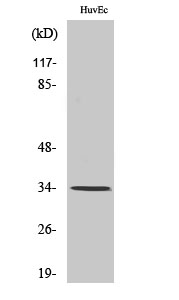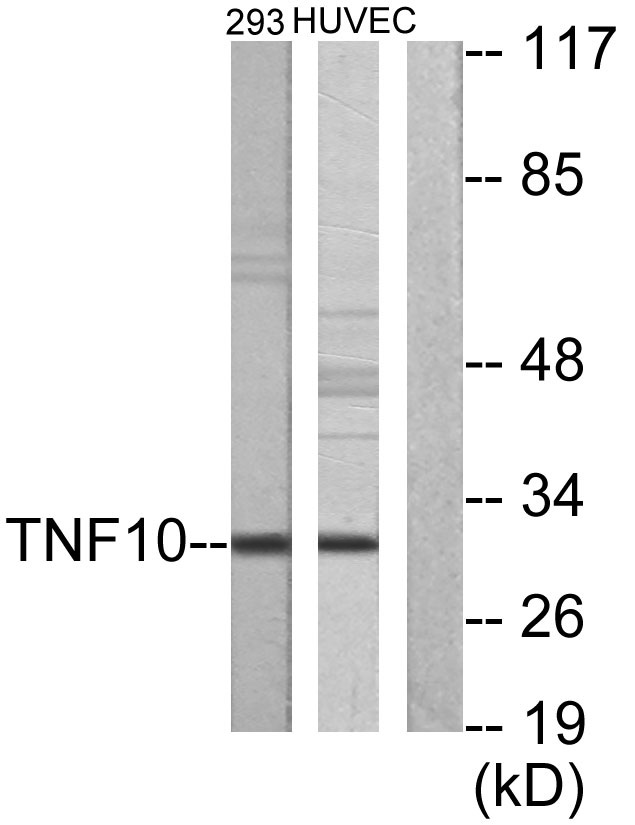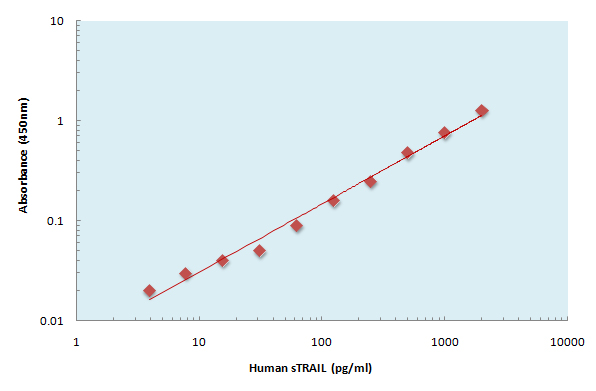TRAIL Polyclonal Antibody
- Catalog No.:YT4721
- Applications:WB;IHC;IF;ELISA
- Reactivity:Human;Mouse
- Target:
- TRAIL
- Fields:
- >>Cytokine-cytokine receptor interaction;>>Viral protein interaction with cytokine and cytokine receptor;>>FoxO signaling pathway;>>Apoptosis;>>Necroptosis;>>Natural killer cell mediated cytotoxicity;>>Pathogenic Escherichia coli infection;>>Salmonella infection;>>Influenza A;>>Lipid and atherosclerosis
- Gene Name:
- TNFSF10
- Protein Name:
- Tumor necrosis factor ligand superfamily member 10
- Human Gene Id:
- 8743
- Human Swiss Prot No:
- P50591
- Mouse Swiss Prot No:
- P50592
- Immunogen:
- The antiserum was produced against synthesized peptide derived from human TNFSF10. AA range:31-80
- Specificity:
- TRAIL Polyclonal Antibody detects endogenous levels of TRAIL protein.
- Formulation:
- Liquid in PBS containing 50% glycerol, 0.5% BSA and 0.02% sodium azide.
- Source:
- Polyclonal, Rabbit,IgG
- Dilution:
- WB 1:500 - 1:2000. IHC 1:100 - 1:300. IF 1:200 - 1:1000. ELISA: 1:20000. Not yet tested in other applications.
- Purification:
- The antibody was affinity-purified from rabbit antiserum by affinity-chromatography using epitope-specific immunogen.
- Concentration:
- 1 mg/ml
- Storage Stability:
- -15°C to -25°C/1 year(Do not lower than -25°C)
- Other Name:
- TNFSF10;APO2L;TRAIL;Tumor necrosis factor ligand superfamily member 10;Apo-2 ligand;Apo-2L;TNF-related apoptosis-inducing ligand;Protein TRAIL;CD antigen CD253
- Observed Band(KD):
- 30kD
- Background:
- The protein encoded by this gene is a cytokine that belongs to the tumor necrosis factor (TNF) ligand family. This protein preferentially induces apoptosis in transformed and tumor cells, but does not appear to kill normal cells although it is expressed at a significant level in most normal tissues. This protein binds to several members of TNF receptor superfamily including TNFRSF10A/TRAILR1, TNFRSF10B/TRAILR2, TNFRSF10C/TRAILR3, TNFRSF10D/TRAILR4, and possibly also to TNFRSF11B/OPG. The activity of this protein may be modulated by binding to the decoy receptors TNFRSF10C/TRAILR3, TNFRSF10D/TRAILR4, and TNFRSF11B/OPG that cannot induce apoptosis. The binding of this protein to its receptors has been shown to trigger the activation of MAPK8/JNK, caspase 8, and caspase 3. Alternatively spliced transcript variants encoding different isoforms have been found for this gene. [provi
- Function:
- cofactor:Binds 1 zinc ion per trimer.,function:Cytokine that binds to TNFRSF10A/TRAILR1, TNFRSF10B/TRAILR2, TNFRSF10C/TRAILR3, TNFRSF10D/TRAILR4 and possibly also to TNFRSF11B/OPG. Induces apoptosis. Its activity may be modulated by binding to the decoy receptors TNFRSF10C/TRAILR3, TNFRSF10D/TRAILR4 and TNFRSF11B/OPG that cannot induce apoptosis.,similarity:Belongs to the tumor necrosis factor family.,subunit:Homotrimer.,tissue specificity:Widespread; most predominant in spleen, lung and prostate.,
- Subcellular Location:
- Cell membrane ; Single-pass type II membrane protein . Secreted . Exists both as membrane-bound and soluble form. .
- Expression:
- Widespread; most predominant in spleen, lung and prostate.
- June 19-2018
- WESTERN IMMUNOBLOTTING PROTOCOL
- June 19-2018
- IMMUNOHISTOCHEMISTRY-PARAFFIN PROTOCOL
- June 19-2018
- IMMUNOFLUORESCENCE PROTOCOL
- September 08-2020
- FLOW-CYTOMEYRT-PROTOCOL
- May 20-2022
- Cell-Based ELISA│解您多样本WB检测之困扰
- July 13-2018
- CELL-BASED-ELISA-PROTOCOL-FOR-ACETYL-PROTEIN
- July 13-2018
- CELL-BASED-ELISA-PROTOCOL-FOR-PHOSPHO-PROTEIN
- July 13-2018
- Antibody-FAQs
- Products Images

- Western Blot analysis of various cells using TRAIL Polyclonal Antibody. Secondary antibody(catalog#:RS0002) was diluted at 1:20000

- Immunofluorescence analysis of A549 cells, using CD253 Antibody. The picture on the right is blocked with the synthesized peptide.

- Western blot analysis of lysates from HUVEC cells and 293 cells, using CD253 Antibody. The lane on the right is blocked with the synthesized peptide.


